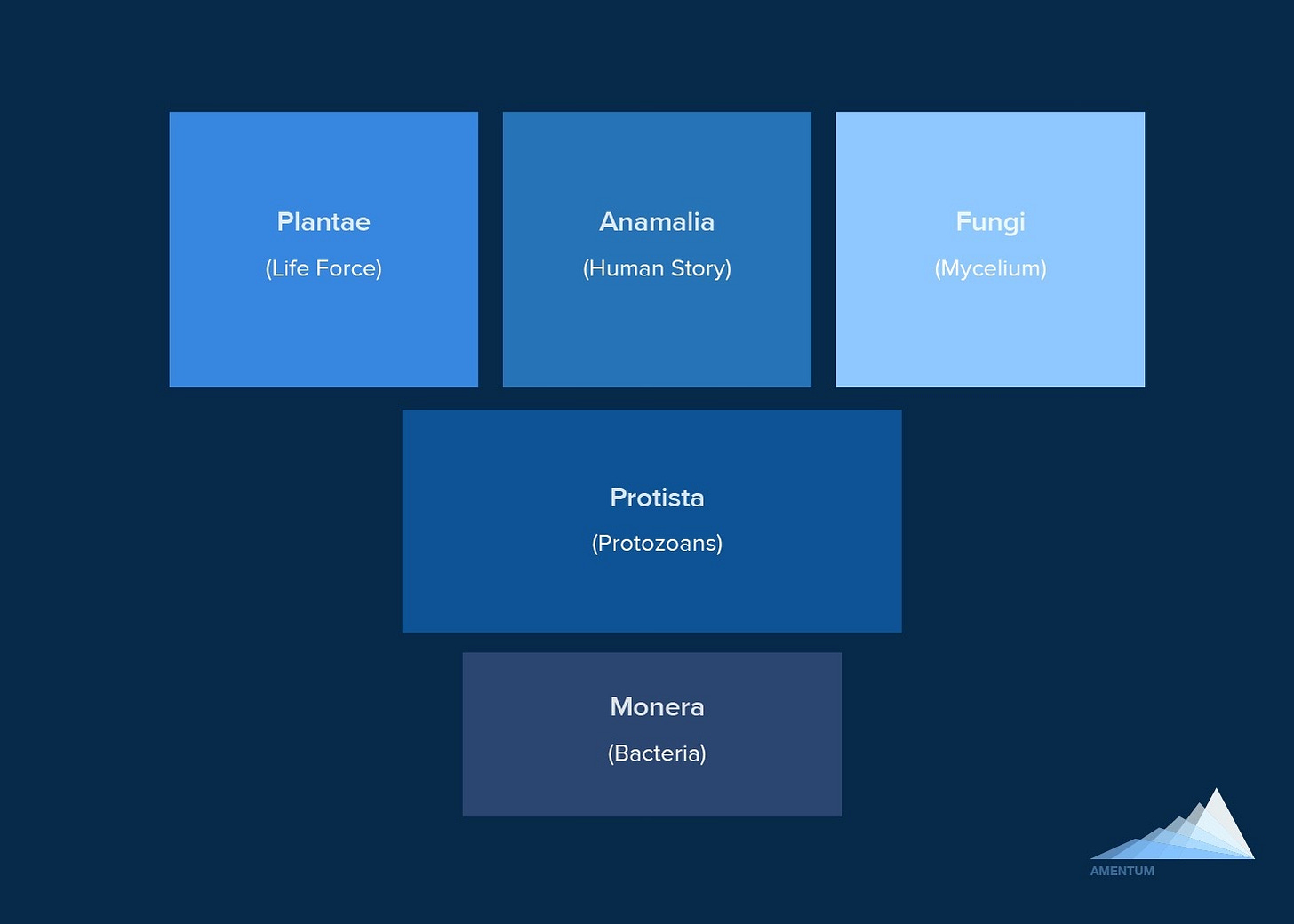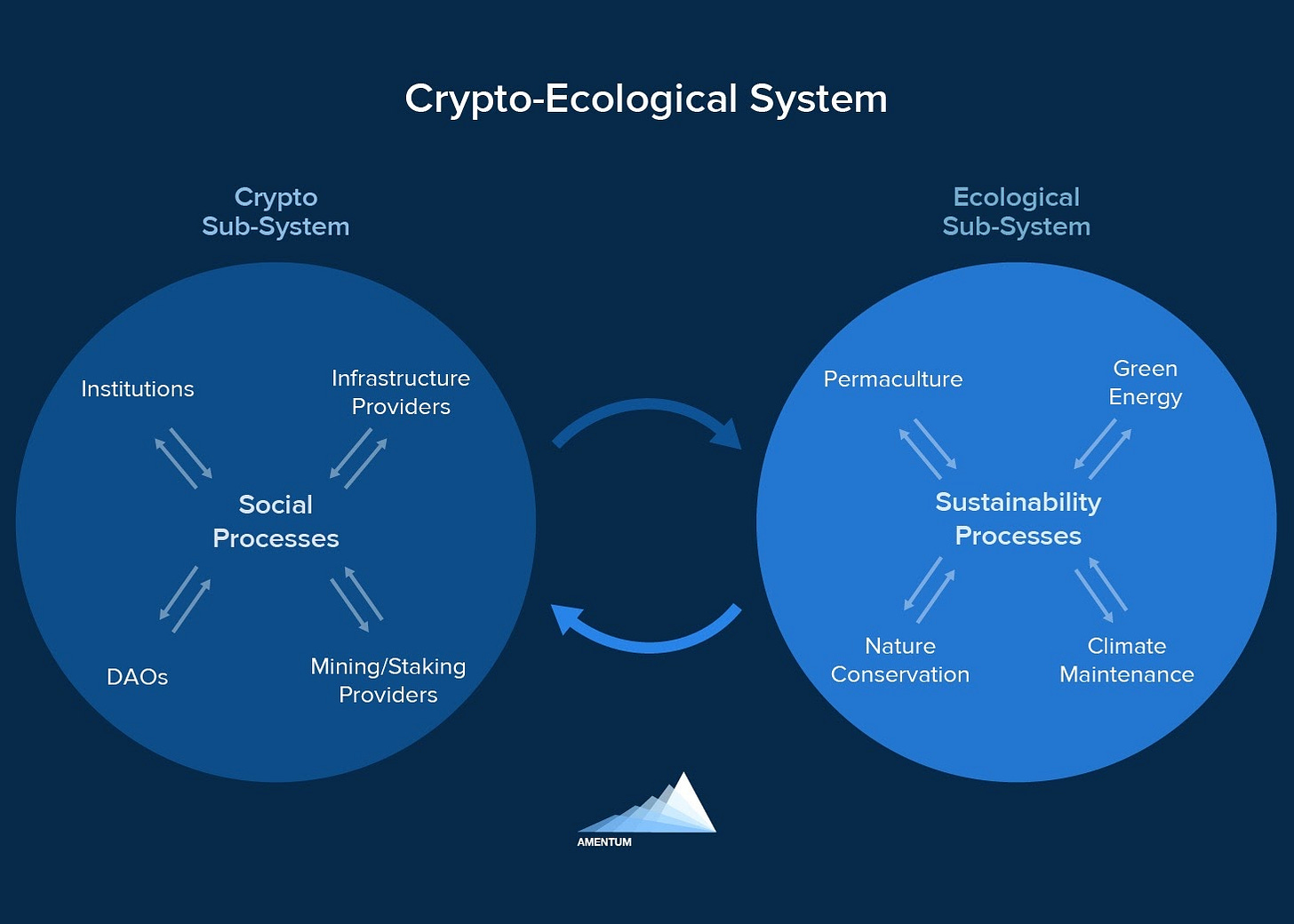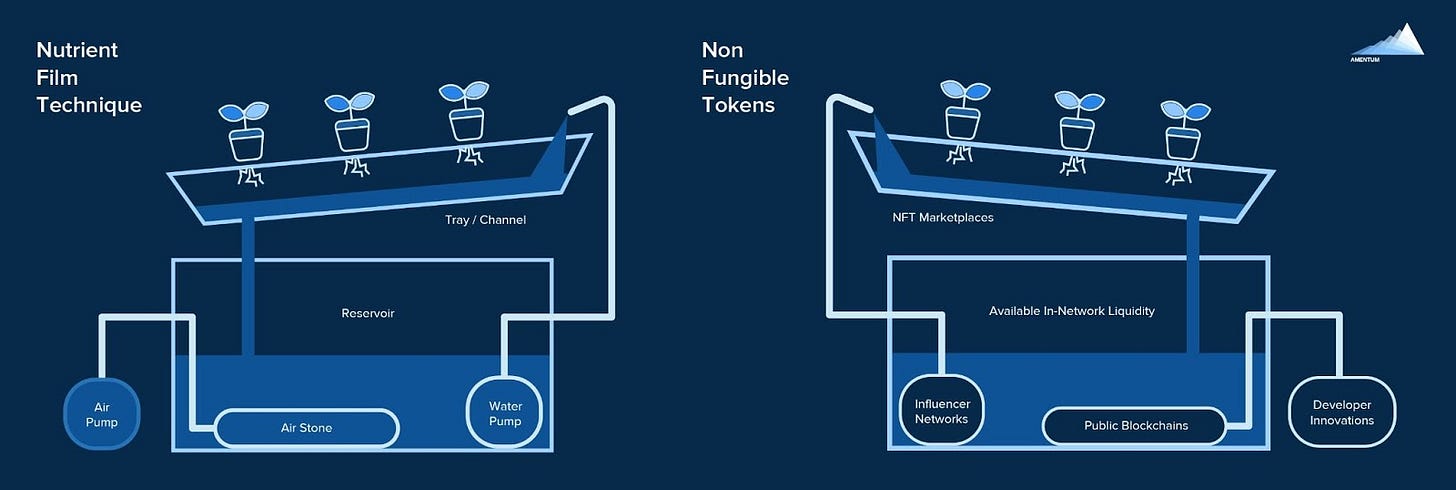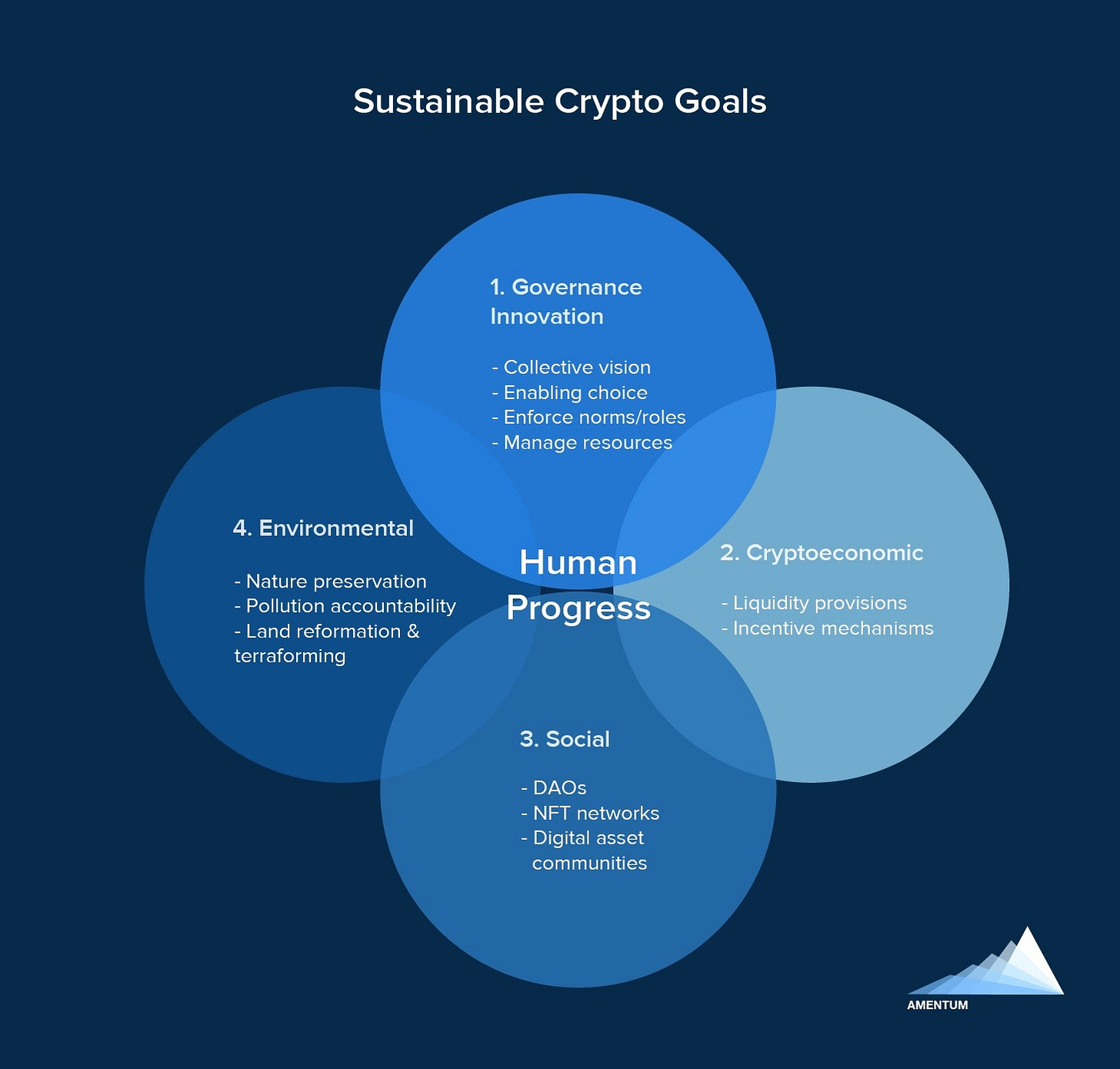By: Steven McKie (Amentum Capital, CEO)
As we have endured this very tumultuous last year, we have all grown in our own ways more resilient as communities, individuals, and organizations purely from all having to face the same challenges globally. This network of agony and the aid of loving reciprocity that follows to pick up the pieces, is just another metaphor for the complex human condition and our small piece of the puzzle we control together as a species.
Humanity continues to progress itself technologically, spiritually, and financially, by working together through these enigmatic social metamorphoses -- it is a tale as old as time itself. A fate that we cannot escape; so if that is the case then we had best learn to observe and adapt, naturally.
We as a collective, the planet, have to move from the internal combustion and focus on the sovereign individual, to understanding the importance of the “mycelic individual”. An evolved consciousness that exists externally from itself. That is the lesson that nature teaches us that we absentmindedly ignore repeatedly throughout history.
If you’ve been in crypto awhile, you’ve likely heard it or bitcoin compared to mycelium; which is a composition of grand fungal networks that exist underground and are the “internet of flora and fauna” and their internal communications and resource distribution networks. They have lasted the longest because they are the external combustion engine of nature itself. They outsource the digestion and gestation to a greater ecosystem that will compete for energy. The fungus does not belong in the plant or animal kingdom, it exists in its own unique category; for it completes the trinity of creation visible to the human eye, with protozoans and bacteria being invisible to the naked eye.
[Figure 1: Kingdom diagram to understand where our greater human story stands amongst nature.]
Cryptoeconomic Recomposition
Continuing this long extended metaphor, when we mix in crypto-based incentives, air (as life giving oxygen) becomes a liquid; in this case it becomes financial liquidity. The air becoming liquidity in this metaphor is simply the substrate that informational value exchange carries itself across, and it helps maintain the integrity of the network in doing so. Ultimately this breathes life into new economic experiments, empowering more classes and niche groups of people. So what we can begin to see here is the mirrored effects of systems in nature, and those we’ve created here natively online with open money systems like Bitcoin and Ethereum.
As humanity continually seeks to make itself more fault tolerant, we have to take the lessons learned here from the mycelium networks that came before us, and take those organic algorithms refined by nature to space, and back. But, we have to first understand at a high-level the mechanism and what it looks like. We have to understand the system of networks that make us who we are. We are humans of Earth, so we have to adopt that collective symbiosis with us everywhere we go; both digitally online in our major communications networks, and the physical in-person communities of every collective consciousness that plays their role in the story of what it ultimately means to be human.
In recent years a new approach has emerged that studies the interrelationship between ecological and biological systems -- originally developed by R.W. Sterner, J.J. Elser and their collaborators. This is called “biological ecology”, because it focuses on the chemical requirements of each trophic level, in addition to its associated energy requirements. Essentially, this new type of science recognizes that organisms (and their survival) are outcomes of chemical reactions, and therefore organisms are constrained by supplies of key chemical elements, such as carbon, nitrogen, and phosphorus.
The mirror here is that our cryptoeconomic systems are also constrained by their ability to access liquidity, as well as key physical custodians of the network itself which maintain its codebase and necessary infrastructure. Therefore, by mapping and mimicking these natural systems and understanding why they work well in nature, we can create the most resilient technologies possible, with the highest propensity for success.
We have to remember, in crypto, that a lot of the hard work has already been done by those wiser and more experienced than us -- in even more specialized fields. It’s up to us to find those intersections of science and nature, and blend them with what we’re building everyday in crypto.
[Figure 2: This diagram shows the feedback loops present in crypto that maintain our collective incentives that make all of this work. However, we must mirror these systems with ecological considerations that create and sustain concurrently, while we scale this next generation financial/governance system.]
The crypto-ecological system that can emerge from our awareness of these sub-systems will be one of our most substantial contributions to the planet. As others work to provide the capital, liquidity, infrastructure, and innovation, as will others in blending those rich resources with creating complementary systems that regenerate local ecosystems/communities and nature itself.
As we blend further, we will naturally trend towards balance, with less dependence on zero-sum economic activities that ignore their negative effects on our society, local wildlife and nature preservation.
Mirroring Natural Processes
To provide another series of examples, this one will illustrate the similarities between a concept in hydroponics called the “nutrient film technique” (NFT, sound familiar?) The nutrient film technique is a trough/nutrient mechanism that allows a shallow stream of water carrying dissolved nutrient loads that are required for plant growth, and recirculates it past the roots to sustain their life and growth.
This can be compared to the process by which NFT (non-fungible token) artists seek to find buyers and liquidity for themselves from a community of art collaborators, collectors, and fans. These NFTs are naturally also reliant on the underlying trough and nutrients that are the public blockchains they operate on (i.e. Ethereum), and their associated on-chain liquidity the nutrients by which can sustain the starving artist.
[Figure 3: Showcases the NFT (Nutrient Film Technique) process borrowed from hydroponics, mirrored against cryptoeconomic value transfers with NFTs (Non-Fungible Tokens) that create artistic and financial value for growth.]
What we should now be able to see further is that everything is a cycle, a mechanism derived from nature, mathematics, chemistry and physics (or best expressed as a duality: the physical/metaphysical). It requires energy to move objects through a system digital and physical, so when we continue to make these comparisons, we can be more confident in our mechanism design being optimized against its most pure benchmark, nature itself, and the sustained processes it needs to create life.
The Decentralized Exchange Grid (aka the ‘DexGrid’)
“Change the tools; change the rules; change the culture; change society”. This is a mental model, mindset and mantra I’ve developed to understand how to upgrade and swap out living, breathing, financial systems run by central governing bodies— and replacing them with drop-in protocols and primitives so they can be retrofitted to benefit the global collective.
Now before I move forward, I will assume that you’ve become aware of the benefits of public blockchains, and the economies of scale that are incentivized through Proof-of-Work mining and infrastructure deployment. If not, read here as well here to get up to speed (there’s a great video commissioned by Square and ArkInvest too, here).
The upcoming rise of the decentralized grid (DexGrid) can be best defined as the intersection of information/value/energy exchange, in one constant incentive creation mechanism that further blends ecological sustainability and human innovation.
Crypto + Permaculture
However, ultimately it will be up to states, cities, and federal governments to experiment with subsidies to promote an environment of experimentation, so legal regulators and software developers can work together more easily in tandem. A relevant quick example is the deployment of government subsidies to aid in the adoption of electric bicycles, like those recently in the San Francisco Bay Area.
Imagine if your local or federal government subsidized your Proof-of-Stake mesh hardware purchases, such as a Helium node, and enabled you a cheaper means of passive income while directly making local communications networks more fault tolerant.
You can even get more granular and subsidize the deployment of environmental sensors, such as the temperature and humidity in concrete, to create futures for new public infrastructure being built in real-time. The possibilities are endless, and I could go on for quite some time on merging P2P markets with just-in-time sensor data.
However, one of the fundamental issues with innovative concepts as described above, is the privacy and security of the information being pulled from these data sources. Democratically governed and controlled information infrastructure is a powerful idea, but they should not become monopoly toll roads that disempower the individual powers of a free populace.
Everything can be built safely on sound primitives that evolve in time. And, there’s the added benefit that these ideas/primitives can be reapplied in a myriad of ways. In fact, many successful experiments already being set in motion by existing companies operating in the “real-world”:
Solar mining and green initiatives for deploying recirculative green houses using excess stored solar energy.
Efforts such as DexGrid working to enable the deployment of clean energy microgrids that accelerate the development of green energy production for localities with unsustainable energy access -- as we’ve seen with the U.S. territory Puerto Rico follow major hurricanes.
Mattereum as an example of supply chain and provenance platforms that can enable us to track production, collectibles, and more unique assets like carbon credits with real-world legal accountability. All of this without losing capital efficiency by utilizing a series of legal underwriters providing value to the underlying non-fungible asset the legal instruments create.
Connext Network with their ability to provide “just-in-time” on-chain agnostic capital through networks of decentralized liquidity routers in a hyper efficient manner, while enabling VISA-like monetization through fees for larger community hubs. This is horticulture for money essentially; allowing for expanded capital efficiency and the growth of new monetary experiments in an expedited manner.
Crypto apps and services such as Namebase and Cent that allow users to extract non-fungible value from crypto protocols. This enables passive income from a self-manageable platform, creating sustainable income streams for individuals seamlessly provided by the decentralized web and the liquidity from decentralized finance.
Later at scale once we’ve refined systems as described above, we can utilize it all to enable agri-permaculture that focuses on getting capital into the hands of small farmers and growing co-ops that can make our food systems more resilient and efficient. I sought to find an example of someone already laying the foundation for such efforts, and I was introduced to Regen Network, which uses economics to drive regenerative land management. There are other similar efforts as well, but it is clear everyone seems to be on the same page as far as where all of this capital abundance and financial innovation should lead us prosperity wise.
To fully complete this system, you’ll need to enable localities the ability to create and access liquidity for their community derived currencies (without a centralized feudal lord providing subsidized liquidity, that would be a step back). Then, as we continually lift small and medium sized farmers out of poverty, globally, it’ll present more opportunities for economic expansion and growth for direct investment into their local citizens and ecological sustainability -- without robbing them of equity and ownership of their plant infrastructure and production output.
The Top-Down Vision
Now that we understand what natural systems mirroring can look like, and how to shorten the cycle of scientific discovery and real-world innovative deployment --that is sustainable-- we can focus on what that gives us.
Our more crucial human initiatives for the future:
Deploy and improve technology so that it serves us, globally, always and forever by design.
Improve Earth to achieve an agreed upon vision of real harmony.
Advance knowledge by exploring science and the unknowns of space.
Speculate on real-time data with futures to prevent dystopia.
To put it simply, the end game is community owned connected economies of scales. We have the ability now to build these visions first online, and allow them to slowly manifest into the real world thanks to their embedded in-network incentives. This is also how we slowly merge online governance, with federal governments, in a seamless and non-destructive manner. Which also allows for unbounded returns for those massive wealth incumbents to make the transition without much fuss, too; retaining a bit of their influence while still gaining wealth. This overtime creates emergent harmony, through pluralism and ever-present disagreement, which iteratively will get us to community owned economies of scale.
[Figure 4: Combined, we can make crypto development sustainable by keeping an eye on how each of these different segments interface with one another. The intersection of these four quadrants is what human progress is made up of. Creating a ”cryptoeconomic flower of human progress”.]
Inevitably though, all of that value will find its way back to the people, in time. It cannot be avoided as in the future the most valuable institutions will be community owned networks powered by cryptoeconomics. This is my firm belief that as you amass a certain amount of wealth and influence, the only remaining upside in this new digital/physical hybrid world of value will be to give it back to the public.
Our focus now should be on observing what powers have accumulated thus far, then work to redistribute them; instead of waiting for power to concentrate once more and creating that societal debt to rebalance later.
There is a theory I call the “theory of penultimate reach”, wherein you’ve accumulated so much centralized power and influence, it can only be monetized further by giving it back to the public. And, if these systems continue to mimic and mirror nature, then eventually everything (big or small) will die and be reabsorbed back into the system.
This is the natural balance of all things, organic or inorganic, and our human-made systems cannot avoid them either, in the end. Eventually everything returns to source, and economic systems run on energy created from the interactions of everyday people like you and I, plus nature itself.






